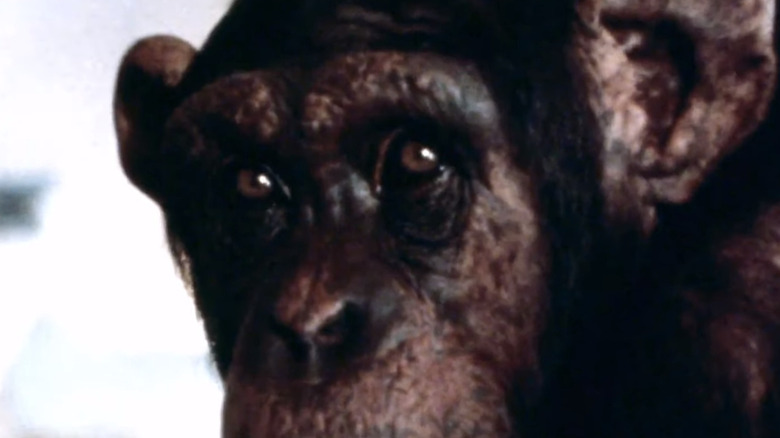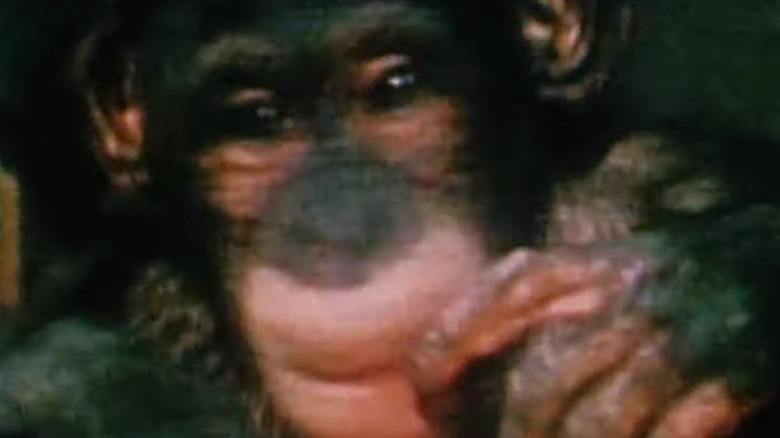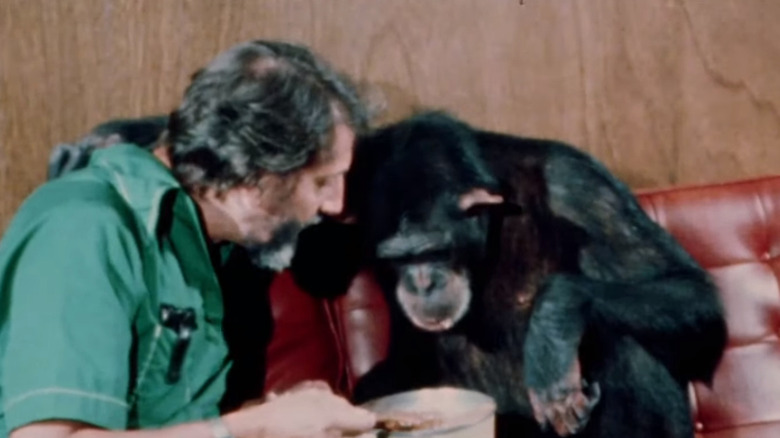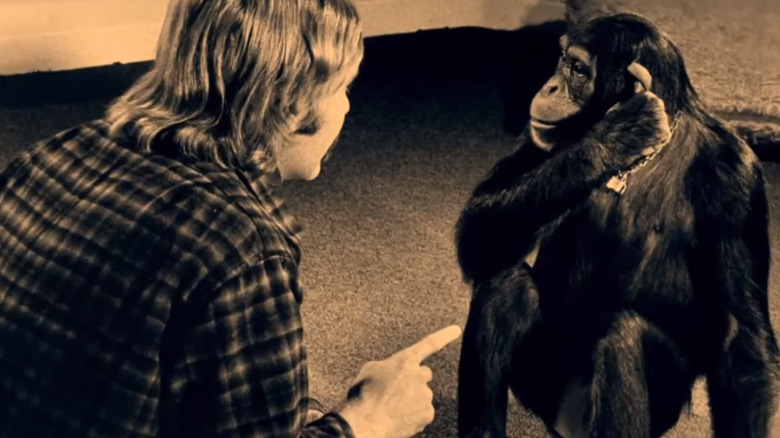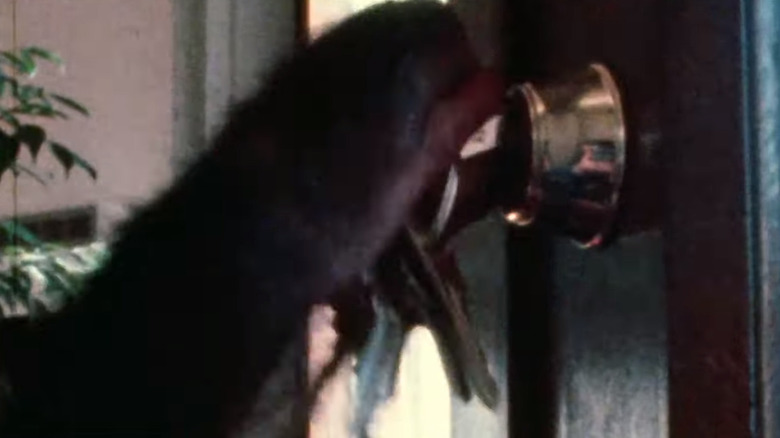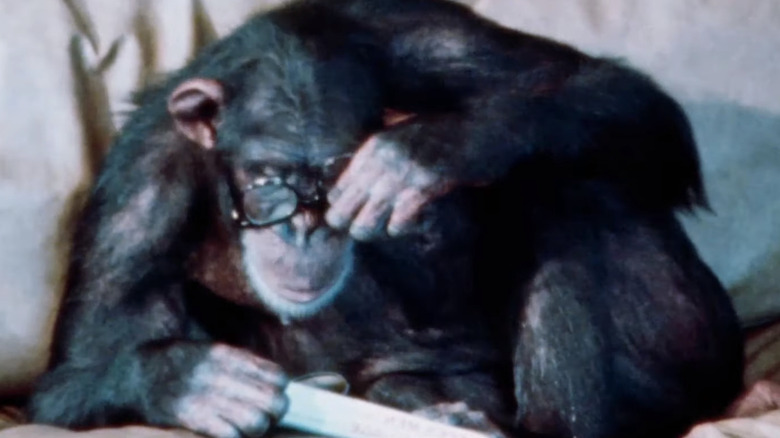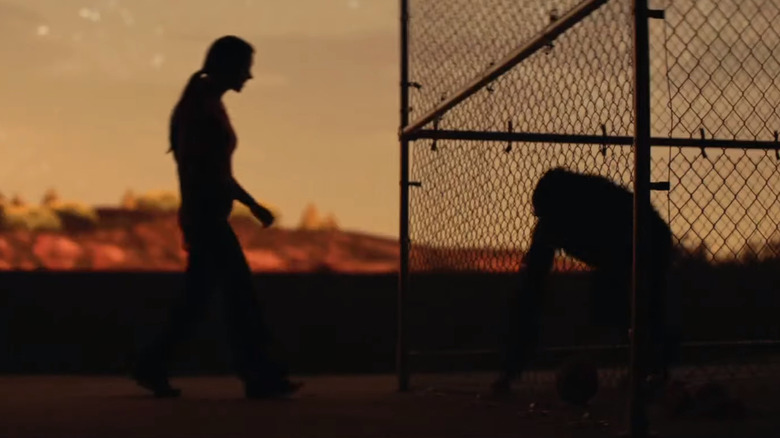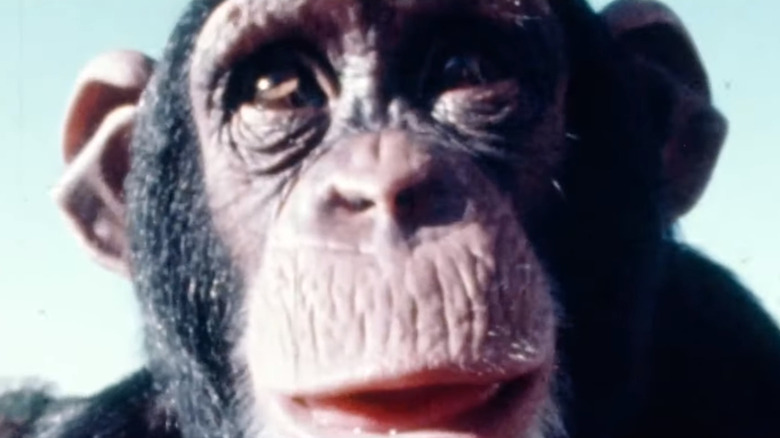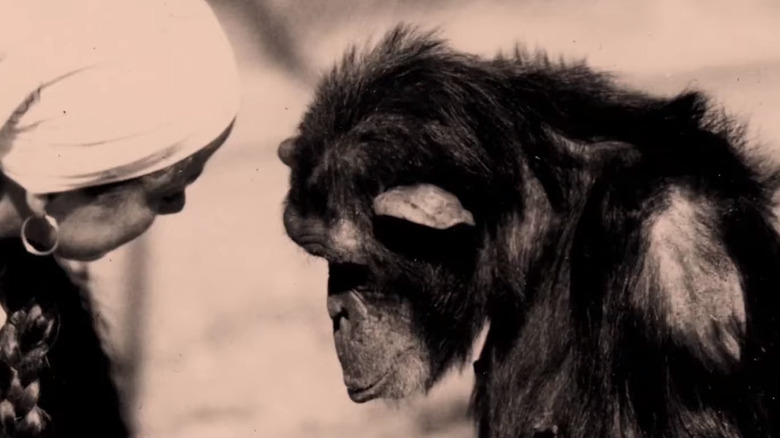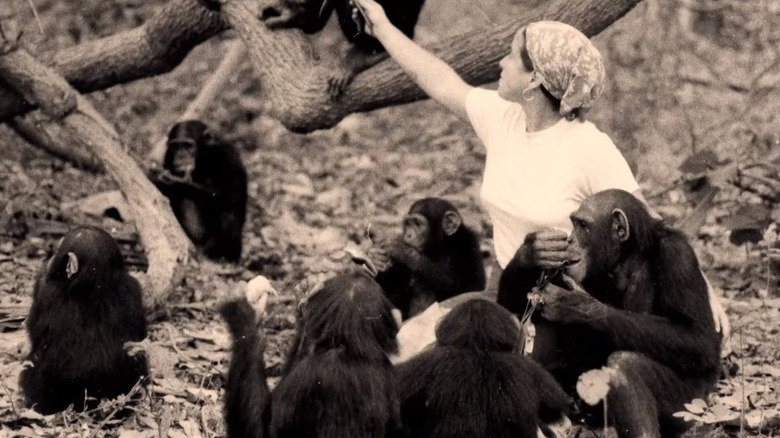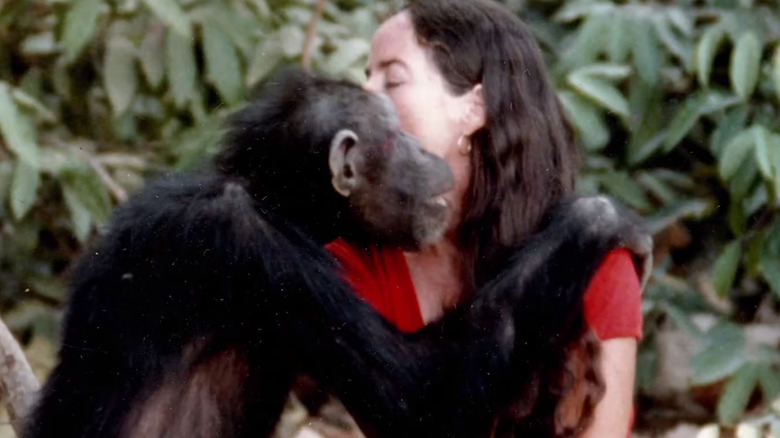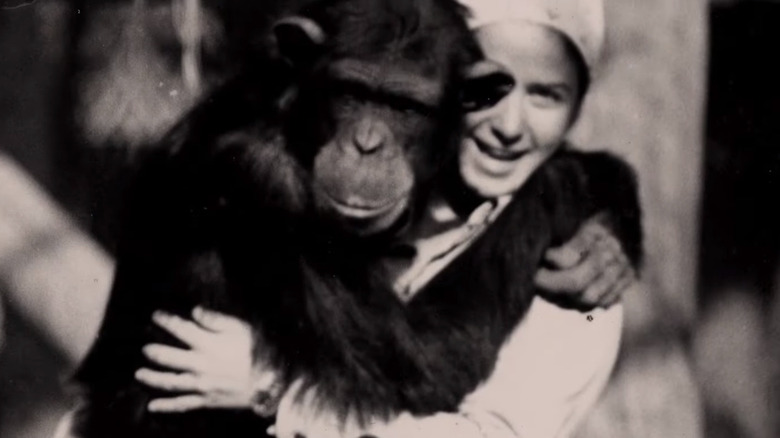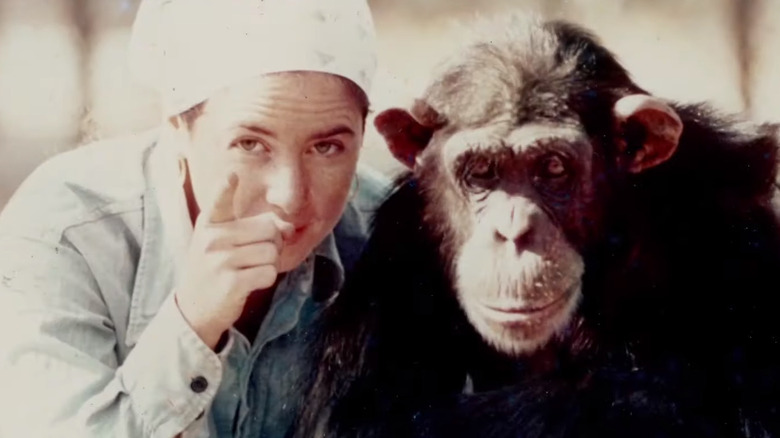The Tragic Story Of Lucy The Chimp
The conveniences and lifesaving technologies humanity enjoys today highlight the importance of science in everyday life. Sadly, the history of global innovation and discovery includes numerous controversial and unethical activities, many times involving human subjects.
Nowadays, such experiments would be heavily criticized by the public and shut down as quickly as possible. In the past, however, researchers who participated in these tests didn't know any better — or perhaps, they were just better at ignoring their consciences in their pursuit of knowledge.
Interestingly, one of the most infamous examples of experiments with questionable ethics didn't involve a human test subject but a chimpanzee. And while it did end up contributing to society's understanding of what sets humans apart from other primates, the toll it eventually took on the test subject may have been too much of a price to pay. This is the tragic account of Lucy, the chimpanzee that was raised like a human child.
Lucy was taken from her mother at birth
Lucy's story began in 1964, when she was born at a roadside zoo called Noell's Ark Chimp Farm in Florida. Had things gone differently, she likely would have followed in the footsteps of her parents, who were both performers at the carnival.
As fate would have it, though, a language researcher and psychologist named William Lemmon bought Lucy when she was just two days old. Lemmon was the founder and director of the Oklahoma-based Institute for Primate Studies (IPS) and had a reputation for his experiments involving chimpanzees. Animal People claims that Lucy was reportedly meant to be returned to the carnival after the study's conclusion, which did not happen.
According to The Guardian, Lucy's foster parents, psychologists Maurice and Jane Temerlin, took her while her mother was sedated. The Temerlins brought Lucy home as part of what would become a controversial — and ultimately tragic — experiment.
Lucy was raised like a human child in a very long experiment
In the Temerlin household, Lucy was not raised as a pet but as a human child. Even the manner in which she was brought home from the carnival reflected this. As described in a "Radiolab" podcast episode, Jane, who picked the name Lucy for the newborn chimp, "brought her home on a commercial airline, carried in a bassinet, her face covered with a lacy blanket" (via WNYC Studios).
According to The Telegraph, Lucy grew up alongside the Temerlins' ten-year-old child. The couple wanted to see if being raised like a person could override Lucy's natural, non-human instincts. It's worth noting that at the time, primatology was experiencing a surge in popularity, with the efforts of Jane Goodall and other experts driving a lot of attention to the field (via The Guardian).
In his book "Lucy: Growing Up Human: A Chimpanzee Daughter in a Psychotherapist's Family," Maurice described Lucy's remarkable development: "She quickly learned to hold her own bottle. At two months, her eyes would focus. At three months, she was trying to climb out of her crib to go to people, and at six months, she was pretty mobile on all four limbs" (via WNYC Studios). Lucy even learned how to use a spoon and fork, as well as how to put clothes on (via Beacon Broadside). All of these were for the purpose of answering a single question: "With the right upbringing, how human could Lucy become?"
Lucy learned American Sign Language
About six years after Lucy's birth, the next phase in her education began — and it was in the hands of a man whose claim to fame was successfully teaching a chimp American Sign Language (ASL) that same year.
According to New Scientist, primatologist Roger Fouts managed to teach Lucy about 100 ASL signs. In WNYC Studios' "Radiolab" feature, Fouts shared that he'd stay at the Temerlins for hours, fulfilling the roles of teacher, friend, and babysitter all at once. Aside from teaching Lucy ASL, Fouts also accompanied her on walks around the neighborhood and even read books with her.
Some have questioned whether Lucy and other chimps who were taught ASL actually understood the signs they were making. Fouts mentioned a couple of incidents that support this idea. Once, Lucy called a watermelon "candy drink" after she had a taste of it. In contrast, she made the hand signs for "cry hurt food" after consuming an old, unpleasant-tasting piece of radish. Interestingly, Fouts also believed that Lucy had learned how to lie as well: He spoke of an instance during which Lucy defecated in the room despite being potty-trained, blamed one of Fouts' grad students for supposedly making the mess, and subsequently confessed and apologized.
Lucy became accustomed to life as a human (and a celebrity)
As time went on, Lucy developed habits and behaviors that were uniquely human. Aside from putting on clothes and visiting fast food outlets (via The Telegraph), Lucy also knew how to make tea.
Fouts and his grad student Sue Savage-Rumbaugh recalled in their interview with "Radiolab" (via WNYC Studios) how Lucy would almost immediately start making tea every time they walked into the Temerlins' residence. Savage-Rumbaugh, in particular, was struck by the "incongruity of it all," citing Lucy's nonchalant demeanor throughout these actions as particularly noteworthy. "[Lucy would] walk casually into the kitchen and search through the cupboard for the kind of tea she wanted that day, put some water in a kettle and put it on the stove, and make us tea," she described, as if it were perfectly normal for a chimpanzee to act that way. After serving them tea, Lucy would sit down and start listening to radio programs or browsing any magazines she could get ahold of.
Lucy attracted media attention and even landed a spot in Life magazine (via The Brooklyn Rail). According to The Guardian, Maurice mused in his journal: "We wondered how chimp she would turn out to be, or how human?"
Lucy was more interested in humans than chimpanzees
Upon reaching maturity, Lucy also demonstrated some rather adult preferences. For starters, she developed a penchant for drinking alcohol, with straight gin being her poison of choice (via Beacon Broadside). She also appeared to enjoy going through raunchy magazines. In fact, there were a few documented instances in which she'd ... take care of herself while looking at them, with the "assistance" of a vacuum cleaner extension (via Gelf Magazine).
Interestingly enough, Lucy reportedly showed sexual interest exclusively for humans. Attempts at introducing a male chimpanzee as her partner ended in failure, as she seemed to be repulsed by the idea of mating with her own kind. When she was first introduced to a male, she was reportedly frightened when the chimp extended his hand to her. She even tried to put as much distance between the two of them as possible (via WNYC Studios). At this point, it seemed unlikely that Lucy would ever be able to reproduce.
Lucy met and befriended her caretaker Janis Carter
With Lucy's continued growth came increasingly aggressive tendencies. Soon, the Temerlins found her to be quite a handful. It reached the point where they couldn't coexist peacefully with Lucy, and they were left with no choice but to set up a cage for her on top of their roof, isolating her and keeping her away from the humans living inside (via The Telegraph).
Unable to leave their "daughter" that way without at least trying to provide proper care for her, the Temerlins decided to hire a caretaker for Lucy. In 1976, then-graduate student Janis Carter applied for the job. The 25-year-old was greatly interested in primate studies, and she saw this as a welcome opportunity. Upon hiring Carter, the Temerlins stressed that under no circumstances should she touch Lucy (via The Guardian).
Initially, Lucy acted like a "very arrogant, very condescending" ward, as Carter couldn't understand what the chimp was trying to say through sign language. However, things changed one day, when Lucy signaled to Carter that she wanted to be groomed. Carter put her fingers through the chain-link fence, effectively breaking the sole rule that her employers had set. This began what would eventually blossom into a tight friendship between chimpanzee and caretaker.
Lucy became too difficult to handle and was shipped off
A year later, the Temerlins realized that Lucy had become too wild and rowdy to continue staying at their home. Stella Brewer, founder and chair of the Gambia-based Chimpanzee Rehabilitation Trust, shared in a letter to Animal People that the Temerlins had contacted her and her father about releasing Lucy into a wild chimpanzee community. "At that time, wild chimp behavior was not well enough known for me or any one [sic] else to realize that this was an attempt more or less doomed from the outset," Brewer wrote.
The Temerlins received the go-ahead to send Lucy the Brewers' way. By this time, however, Janis Carter had already developed such a strong bond with Lucy that the former felt compelled to travel with the latter (via The Telegraph).
The Temerlins and Carter brought Lucy to Gambia, a small country in mainland Africa, where Brewer and her team were busy facilitating the integration of some chimps into a bigger community. According to Brewer, Lucy was intended to join other chimps on a 300-acre island that allowed her to run freely but still gave her access to toys, reading materials, and all the other amenities she had already gotten used to while living as a human child (via Animal People).
Lucy was extremely unhappy in her new life
As told in The Telegraph, the plan was to have Lucy gradually transition from human life to chimp life over the course of two weeks. Unfortunately — and perhaps unsurprisingly — said plan did not go as intended, for Lucy had already gotten so used to the comforts of living like a human that she appeared to be unwilling to settle for anything else.
Overall, Stella Brewer described the attempt to integrate Lucy into a chimpanzee community as an "adjustment" rather than a true rehabilitation (via Animal People). Missing the made-for-human meals she had become accustomed to in the Temerlin household and ill-equipped to find and gather food for herself, the poor primate not only lost a tremendous amount of weight that she reportedly never fully regained but also exhibited signs of extreme depression (via The Guardian).
When Maurice and Jane Temerlin saw this, they gave up hope on a smooth transition for Lucy, opting to simply fly back to the United States. Janis Carter, however, made a decision that probably surprised everyone.
Janis Carter helped Lucy get accustomed to freedom for seven years
Realizing that Lucy direly needed assistance in getting used to her new life, Janis Carter opted to stay with the chimpanzee. The devoted caretaker wanted to be absolutely certain that her ward could fend for herself in this new, unfamiliar setting (via The Telegraph). And so, for nearly seven years, Carter effectively abandoned her relationships and career back home. She cut off all communication with her human loved ones so that she could truly live the life that the chimpanzees had to adopt.
During her extended stay in the chimpanzee community's new home — an island in the Gambia River that had no other denizens — Carter became the de facto leader of the group. She guided ten chimpanzees, including Lucy, as they learned the ropes of living in the wild. The nine other non-humans in the group were either orphaned or abandoned; none of them had grown up in their natural habitat. Interestingly enough, it only took them 12 months to fully adjust to their new life.
On her end, Carter learned how to survive in such an unwelcoming habitat. Her experience was far from pleasant: A dead rat in their water supply (via The Guardian), the steady dissolution of her human-based grasp of time, and torrents of fecal matter from the fearful chimps (who slept above her) were just some of the challenges she had to deal with. Over time, Carter felt that the chimpanzees "fulfilled all [her] human needs."
Everyone thought Lucy had finally found a peaceful home
Janis Carter's stay on the island came to an end in 1985, after a member of the community, a male chimpanzee named Dash, decided that it was his time to lead. He attacked and dragged Carter, who sustained injuries when her body brushed against a thorn bush. After escaping through the river and treating her wounds, Carter realized that Dash had effectively evicted her from the troop (via Smithsonian Magazine).
At this point, Carter had come to see the chimpanzees as her own children; this betrayal hit her deep, even though she knew that she had no choice but to leave the island (via The Telegraph). She did not completely abandon Lucy, though, as she remained part of the chimp rehabilitation efforts in Gambia (via The Guardian).
In 1986, Carter felt that it would be a good idea to visit Lucy and bring her some of her favorite toys from back when she was enjoying life as a child of the Temerlins. Astonishingly, Lucy showed a complete lack of interest in the items. She did, however, embrace Carter tightly upon seeing her, a clear expression of fondness and warmth for a dear friend she hadn't seen in a long time. Lucy then turned her back and walked back into the forest, a sign that her longing for life as a human was finally gone (via The Telegraph).
Lucy died on the island
Sadly, the assumption that Lucy had successfully found a peaceful life in the wild turned out to be wrong, in the worst way possible. Sometime around the end of 1987, a rehabilitation worker named Bruno Bubane stumbled upon a grisly sight: the "widely scattered" and incomplete skeleton of Lucy at Carter's old campsite, partially obscured by leaves (via Animal People). An analysis showed no hint of an accidental death, nor did any signs point to disease, snakebites, or animal attacks as the cause of Lucy's demise. Of particular note was the fact that her hands and feet were completely gone. At the time, people speculated that a hunter or poacher had violently ended Lucy's life and took her extremities as trophies to sell in the black market. For a time, this became the predominant theory about Lucy's mysterious death.
The news of Lucy's death broke Janis Carter's heart. In her grief, the person who had taken care of Lucy for nearly a decade almost decided to fly back to the United States. She reconsidered, however, when she realized that while she could no longer save Lucy, her presence in the area could contribute tremendously to increasing awareness about the chimpanzees and making sure they were safe (via Smithsonian Magazine).
In Maurice's book (via researcher Gloria Lloyd), he wrote the lesson he learned, perhaps a little too late: Releasing chimpanzees raised in captivity into the wild could actually be detrimental — or even deadly — to the primates.
Doubts and regrets over Lucy's life and death
Not everyone was convinced that Lucy met her end at the hands of a poacher. Brewer noted that when Lucy's remains were discovered, it was near the end of the annual rainy season. The resulting humidity, coupled with scavenging animals on the island, could have been the actual reason why Lucy's hands and feet were missing. Brewer maintained that at this point, people could only speculate as to what the true cause of Lucy's death was. She also mentioned that when Lucy died at age 21, she left no offspring behind.
It seems that the one thing the people involved in Lucy's entire ordeal agree upon is the fact that throughout her existence, humans determined the course of poor Lucy's life. From the Temerlins who took her away from her birth mother to the people who forced a domesticated chimpanzee to suddenly live in the wild, Lucy was never in control of her own fate. Sadly, as Brewer noted, Lucy's death may have been "the only event she suffered that was not manipulated" (via Animal People).
Maurice Temerlin died in 1988 (via The Guardian), but not before realizing the terrible consequences of his 12-year experiment. He acknowledged the painful truth in his book: "Though Lucy taught us much and gave us great love and enriched our lives and our growth as people, it was a horrible thing to do to her."
